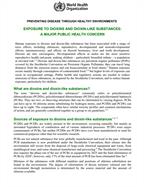Dioxins and dioxin-like substances
Dioxins and dioxin-like substances, including PCBs, are persistent organic pollutants (POPs) covered by the Stockholm Convention. They can travel long distances from the source of emission, and bioaccumulate in food chains.
Human exposure to dioxins and dioxin-like substances has been associated with a range of toxic effects, including chloracne; reproductive, developmental and neurodevelopmental effects; immunotoxicity; and effects on thyroid hormones, liver and tooth development. They are also carcinogenic. Developmental effects in males are the most sensitive toxic end-point, making children – particularly breastfed infants – the population most at risk.
These substances are unwanted byproducts of combustion and various industrial processes, such as chlorine bleaching of paper pulp and smelting. While manufacture of PCBs is now prohibited and their use in equipment is to be phased out by 2025, release into the environment still occurs from disposal of large-scale electrical equipment and waste. General population exposure to dioxins and dioxin-like substances occurs mainly through consumption of contaminated food, but higher levels of exposure can occur in occupational settings.
Actions to reduce emissions of these substances are required by the Stockholm Convention. Interventions to reduce human exposure include:
- identifying and safely disposing of material containing or likely to generate dioxins and dioxin-like substances, such as electrical equipment;
- ensuring appropriate combustion practices to reduce emissions;
- implementing FAO/WHO strategies to reduce contamination in food and feed; and
- monitoring of food items, human milk and air, as well as exposures in workers likely to be exposed to higher levels.
Short document for decision makers

Question & Answers
Tools for action
- WHO/UNEP global surveys of PCDDs, PCDFs, PCBs and DDTs in human milk and benefit-risk evaluation of breastfeeding
- Joint FAO/WHO Food Standards Programme. Proposed Draft Revision of the Code of Practice for the Prevention and Reduction of Dioxins and Dioxin-like PCBs in Food and Feed (2018)
- Toolkit for Identification and Quantification of Releases of Dioxins, Furans and Other Unintentional POPs under Article 5 of the Stockholm Convention (2013)
- Global Environment Monitoring System – Food Contamination Monitoring and Assessment Programme (GEMS/Food) (2010)
- Global Monitoring Plan on Persistent Organic Pollutants Passive Sampling of Ambient Air Methodology and Procedure (2017)
- Global, regional, and national incidence, prevalence, and years lived with disability for 310 diseases and injuries,1990–2015: a systematic analysis for the Global Burden of Disease Study 2015
Norms and guidance values
Most recent WHO evaluation and risk assessment documents
- A review of human carcinogens.
IARC Monographs on the Evaluation of Carcinogenic Risks to Humans, Vol. 100F, pp 339-378. (2012) - Polychlorinated biphenyls: Human health aspects. Concise International Chemical Assessment Document 55
- Polychlorinated dibenzodioxins, polychlorinated dibenzofurans, and coplanar polychlorinated biphenyls
- IARC: A review of human carcinogens. F. Chemical agents and related occupations
- Polychlorinated Dibenzo-para-Dioxins - IARC Summary & Evaluation
- Polychlorinated Dibenzofurans - IARC Summary & Evaluation
- Polychlorinated biphenyls and terphenyls. Environmental Health Criteria 140
Other relevant documents
- PCBs: A Forgotten Legacy? 2028: Final Elimination of PCB (2017)
- UNEP PEN (2016). United Nations Environment Programme. PCB Elimination Network
- The 2005 World Health Organization reevaluation of human and mammalian toxic equivalency factors for dioxins and dioxin-like compounds (pdf)
- Polychlorinated Biphenyl. International Chemical Safety Card 0939
- Furan. International Chemical Safety Card 1257
- International Chemical Safety Card 1467
- PCBs and dioxins in salmon
- The 2005 World Health Organization Reevaluation of Human and Mammalian Toxic Equivalency Factors for Dioxins and Dioxin-Like Compounds
- Code of practice for the prevention and reduction of dioxin and dioxin-like PCB contamination in foods and feeds
- Inventory of Worldwide PCB Destruction Capacity
- Dioxin and furan inventories
- PCB transformers and capacitors: from management to reclassification and disposal
